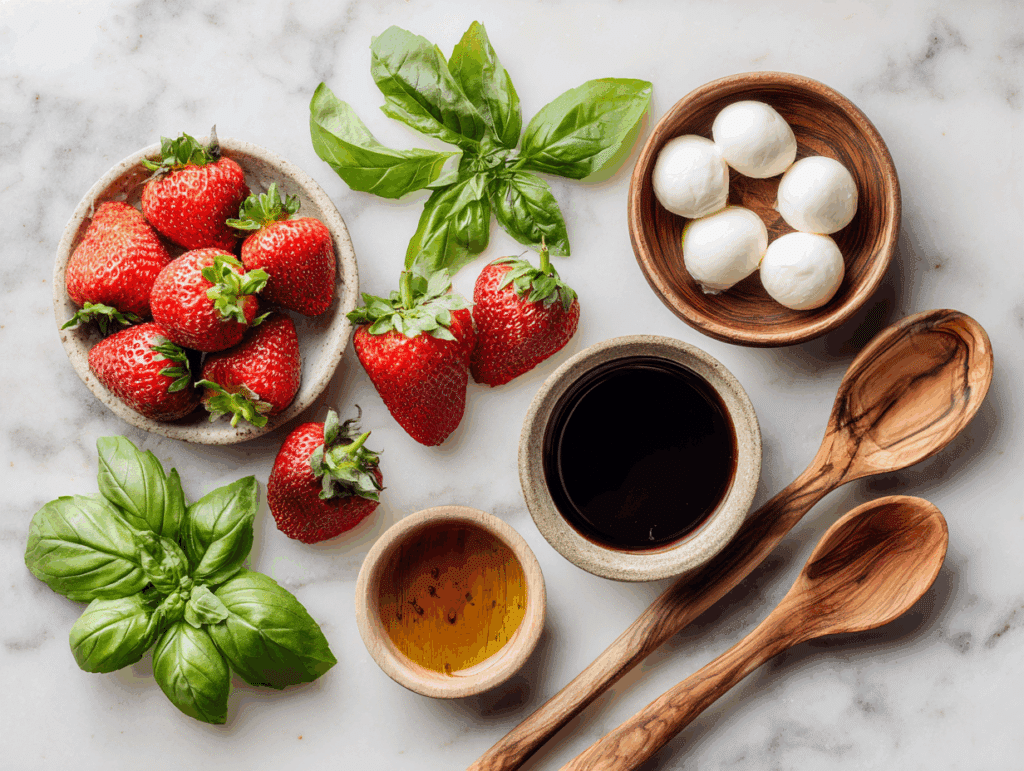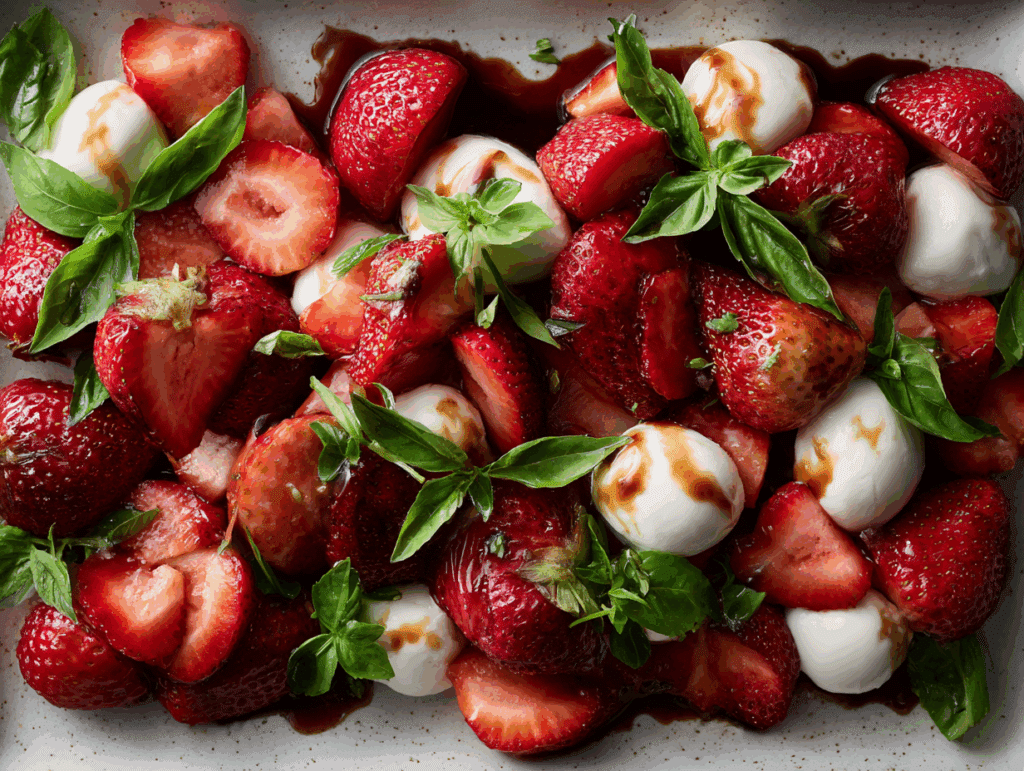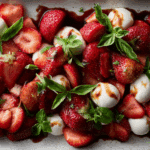If summer had a flavor, I’m convinced it would taste like this balsamic strawberry Caprese. Juicy berries, creamy mozzarella, and sweet-savory balsamic drizzle — it’s sunshine in salad form. In this post, I’ll show you how this twist on a classic Italian Caprese became a staple on my warm-weather table, the best ingredients to use, and tips for layering flavors like a pro. Whether you’re prepping for a picnic, brunch, or backyard dinner, this salad delivers big flavor without heating up your kitchen. Let’s dive into why strawberries and balsamic were meant to be together.
Why Balsamic Strawberry Caprese Is My Go-To Summer Salad
A sweet memory from a sun-drenched trip to Italy meets fresh backyard strawberries
I still remember the first time I tasted real balsamic vinegar in Modena — it was syrupy, rich, and nothing like the watery versions I’d used back home. It was served over cheese and ripe fruit, and my mind was blown. Years later, when I had a bumper crop of backyard strawberries, I decided to toss them with mozzarella and basil, just like a Caprese salad — and finished it with a balsamic glaze. That bite was magic. The strawberries brought a juicy brightness, the basil added herbaceous depth, and the mozzarella mellowed everything into creamy harmony.
This dish became my go-to not just because it’s beautiful, but because it feels like summer on a plate. Every time I make it, I’m transported back to that sunny afternoon in Italy — minus the jet lag. I now serve it on repeat, especially when friends drop by or I need something quick, fresh, and a little bit fancy. It’s also a fun twist for anyone who thinks Caprese has to be tomatoes and mozzarella only.
(You’ll find more no-fuss summer recipes like this in the No-Bake & Quick Treats section — perfect for hot days when the oven stays off.)
What Makes a Strawberry Caprese Different (and Better)
Traditional Caprese is all about balance — creamy, acidic, and herbal. Strawberries flip the script by adding sweet, juicy intensity that tomatoes just can’t match. Especially when paired with balsamic vinegar, their natural tartness enhances the salad’s depth. The sweetness also makes this version more versatile: it can work as a starter, a side, or even a light dessert.
Mozzarella or burrata creates a creamy base that absorbs both the fruit’s juice and the vinegar’s tang. Basil acts like the bridge between savory and sweet. And when you drizzle everything with aged balsamic or a quick homemade reduction, you get layers of flavor that evolve with every bite. It’s comfort food that’s also crisp, refreshing, and totally satisfying.
For more sweet-and-savory mashups, check out the Cookies & Bars — where balance is always key.
Flavor Harmony with Balsamic
Choosing the Right Balsamic for the Perfect Bite
Let’s talk vinegar — because not all balsamic is created equal. When it comes to making a standout balsamic strawberry Caprese, your choice of balsamic vinegar can truly make or break the salad. You want something that enhances the sweetness of strawberries without overwhelming the cheese and basil.
Aged balsamic vinegar (at least 12 years old) has a naturally thick, syrupy texture with a smooth, mellow flavor. It clings beautifully to fruit and cheese and adds depth without the harsh bite cheaper vinegars can bring. If you don’t have aged balsamic, no problem — you can create a similar effect with a quick reduction. Simply simmer regular balsamic vinegar in a small pan over medium-low heat for about 10–15 minutes until it’s thick enough to coat the back of a spoon.
Avoid vinegars that are too acidic or watery — they’ll make your salad soggy and clash with the delicate sweetness of the berries. If you find a balsamic glaze at the store, check the ingredients. Some are loaded with sugar and cornstarch. A high-quality vinegar, reduced naturally, is often the better route.
Want more clever kitchen shortcuts like this? Explore our No-Bake & Quick Treats section for smart summer solutions.
Strawberry Balsamic Vinaigrette vs. Drizzle
Now here’s the fun part — deciding whether to toss your salad with a vinaigrette or keep things elegant with a finishing drizzle. Each method has its strengths.
A strawberry balsamic vinaigrette (made with fresh berries, balsamic vinegar, olive oil, and maybe a touch of honey or Dijon) blends the flavors into every bite. It’s great when you want a more cohesive salad that holds up well, especially if you’re making it ahead or serving it buffet-style.
But for a more dramatic presentation and concentrated flavor hits, a balsamic reduction drizzle is the way to go. Spoon it over the plated salad right before serving — you’ll get pops of sweetness and tang that contrast beautifully with the creamy cheese and juicy strawberries.
For layered flavors and visual wow-factor, I prefer the drizzle. But both are delicious — just tailor your method to the occasion.
Tip: This kind of drizzle also pairs beautifully with desserts like those in our Cakes & Cupcakes section — try it over vanilla bean cake with fresh berries.
Crafting a Balanced Caprese
The Role of Fresh Mozzarella or Burrata
Let’s talk cheese — because in a balsamic strawberry Caprese, it’s not just a supporting act. It’s the creamy backbone that brings balance to the bright acidity and juicy sweetness of the berries and balsamic.
Fresh mozzarella pearls (ciliegine) are the classic choice for ease and clean presentation. They’re mild, soft, and soak up the strawberry and balsamic juices like a sponge. Just be sure to take them out of the fridge 15–20 minutes before serving; cold cheese dulls the flavor and texture.
But if you want to go a little gourmet, burrata is the upgrade your salad deserves. It’s mozzarella on the outside, but when you slice into it, the creamy center spills out and wraps every bite in richness. It’s indulgent, yes — but still light enough to feel fresh. Burrata works especially well if you’re plating individual portions or want to wow a crowd.
Whichever cheese you choose, tear it gently instead of slicing for a more rustic, artisanal feel. This helps the flavors mingle naturally.
For more textures that melt and blend beautifully in your desserts, check out our Cookies & Bars — you’ll notice similar principles of soft meets crisp.
Basil & Texture Boosters That Shine
Fresh basil is non-negotiable — it’s the thread that ties the fruit, cheese, and vinegar together. Go for whole baby leaves or chiffonade strips to keep the herb from overpowering the dish. If you’re feeling adventurous, try a basil-infused olive oil for an extra hit of flavor.
Want to elevate things even more? Add a crunchy element. Chopped pistachios add earthy richness. Candied pecans give a sweet contrast. Even grilled peaches or watermelon cubes work beautifully here if you’re serving this as a centerpiece salad. These texture boosters aren’t just add-ons — they’re balance-makers that give every forkful dimension.
Need ideas for layering flavors and textures? Take inspiration from our Cakes & Cupcakes section — where every ingredient earns its place.
Serve It Like a Pro
Best Ways to Plate Strawberry Caprese for Gatherings
When it comes to plating, Balsamic Strawberry Caprese offers tons of flexibility — and each style makes a different kind of statement.
For an elegant dinner party, layer sliced strawberries, torn mozzarella (or burrata), and basil leaves in a circular pattern on a white platter. Drizzle the balsamic reduction just before serving for a clean, artistic finish. This method works beautifully when you want guests to serve themselves.
For something casual or picnic-friendly, try skewers. Alternate strawberries, basil, and mozzarella balls on cocktail picks, then brush with balsamic glaze. They’re bite-sized, portable, and always a crowd-pleaser.
Hosting a brunch or larger buffet? Toss everything together in a shallow bowl and finish with chopped herbs and a balsamic vinaigrette. It’s rustic, colorful, and easy to prep ahead. If you go this route, serve it chilled but not cold — about 15 minutes out of the fridge will bring out the best texture and flavor.
These options fit seamlessly into a no-cook entertaining strategy. For dessert pairing ideas that also skip the oven, visit our No-Bake & Quick Treats category.
Seasonal Pairings & Menu Ideas
Because it’s both savory and sweet, this Caprese salad plays well across multiple courses. For summer gatherings, I love pairing it with grilled chicken, rosemary focaccia, or chilled rosé. It also complements brunch spreads, especially when served next to quiche, fruit platters, or sparkling lemonade.
For a sweet-and-savory finish, consider a dessert with complementary fruit notes — a lemon cupcake with berry compote, or vanilla cake with balsamic glaze (you’ll find inspiration in our Cakes & Cupcakes section).
Want to make it a full meal? Add a bed of arugula and top with toasted nuts. Or spoon it over grilled sourdough for a deconstructed bruschetta vibe. However you serve it, this dish always surprises and delights — which is exactly what summer food should do.
Frequently Asked Questions
Does Caprese use balsamic vinegar?
Traditional Caprese salad doesn’t include balsamic vinegar — just tomatoes, mozzarella, basil, olive oil, and a pinch of salt. But modern versions often feature balsamic drizzle or vinaigrette for added depth. It’s especially common in variations like balsamic strawberry Caprese, where the acidity enhances the sweetness of the fruit.
What do you do with strawberry balsamic vinegar?
Strawberry balsamic vinegar is perfect for more than just salads. Use it as a marinade for grilled chicken or turkey, drizzle it over vanilla ice cream or fresh berries, or whisk it into vinaigrettes. For a quick appetizer, try a few drops over burrata with crusty bread — it’s a flavor bomb.
What is the secret to a good Caprese salad?
The secret is in the freshness. Use ripe fruit (whether tomatoes or strawberries), high-quality mozzarella or burrata, and real extra-virgin olive oil. Let the cheese come to room temp before serving, and add a touch of flaky sea salt to enhance the flavors. A restrained drizzle of good balsamic ties everything together.
What is the difference between Capri and Caprese?
“Capri” is an island off the coast of Italy, famous for its beauty and breezy Mediterranean vibe. “Caprese” means “from Capri” and refers to the classic Italian salad that originated there — traditionally made with tomatoes, mozzarella, and basil. Over time, the word “Caprese” has come to describe this fresh, simple flavor combination, even in twists like the strawberry version.
Conclusion
Balsamic strawberry Caprese isn’t just a pretty plate — it’s a flavor-forward celebration of summer. From the sweetness of ripe berries to the tang of balsamic and the richness of burrata, this dish checks every box: fresh, easy, and just adventurous enough to feel special. Whether you serve it stacked, skewered, or tossed, it’s sure to surprise guests and become one of those recipes you turn to again and again.
Keep exploring easy, flavor-packed ideas in the No-Bake & Quick Treats and Cakes & Cupcakes sections — where sweet things always happen.
For more colorful, health-forward creations and behind-the-scenes peeks into my test kitchen, connect with me on Facebook and see what’s brewing daily on Pinterest. Your next favorite recipe might just be a scroll away.
PrintBalsamic Strawberry Caprese Salad That’ll Wow Your Summer Table
- Total Time: 10 minutes
- Yield: 4 servings 1x
- Diet: Vegetarian
Description
Sweet, tangy, and refreshing, this Balsamic Strawberry Caprese salad is a stunning twist on the Italian classic. It blends fresh strawberries, creamy mozzarella or burrata, and basil, finished with a rich balsamic glaze.
Ingredients
2 cups fresh strawberries, hulled and halved
1 cup mozzarella pearls or 2 balls burrata
1/3 cup fresh basil leaves
2 tbsp aged balsamic vinegar or balsamic glaze
1 tbsp extra virgin olive oil
Flaky sea salt to taste
Optional: candied pecans or pistachios for crunch
Instructions
1. Arrange the strawberries and mozzarella on a serving platter.
2. Tuck in basil leaves between the layers.
3. Drizzle with olive oil and balsamic vinegar or glaze.
4. Sprinkle with sea salt and optional nuts.
5. Let sit at room temperature for 10 minutes before serving.
Notes
Use high-quality balsamic vinegar or reduce it for a more intense flavor.
Let cheese come to room temperature before plating.
This salad is best served fresh, but can be prepped up to 2 hours in advance.
- Prep Time: 10 minutes
- Cook Time: 0 minutes
- Category: Salads
- Method: No-bake
- Cuisine: Italian-inspired
Nutrition
- Serving Size: 1 plate
- Calories: 220
- Sugar: 10g
- Sodium: 180mg
- Fat: 12g
- Saturated Fat: 7g
- Unsaturated Fat: 4g
- Trans Fat: 0g
- Carbohydrates: 15g
- Fiber: 2g
- Protein: 8g
- Cholesterol: 30mg




